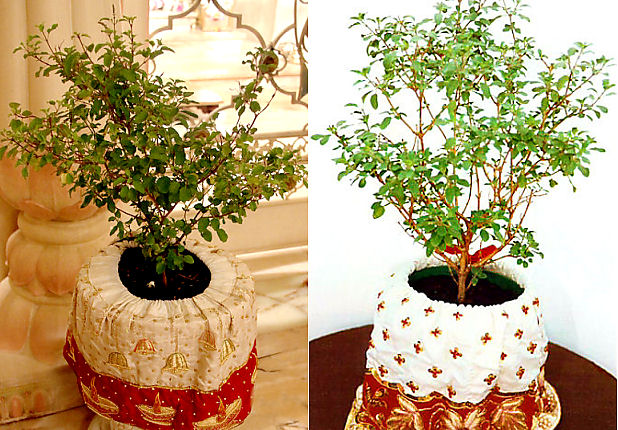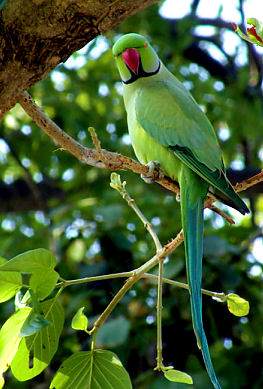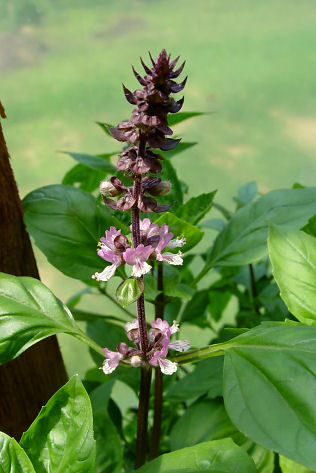- Śrīmatī Vṛndā Devī - - Śrīmatī Tulasī Devī -
Tulsi or Tulasī, the holy basil plant (Ocimum Sanctum) as it is know in the west, is considered to be the beloved of Lord Kṛṣṇa. Tulasī means the "incomparable one". It is the plant of devotion and has spiritually uplifting qualities.
Tulasī is not an ordinary plant, She's Tulasī-Devī, Kṛṣṇa's favorite plant and is worshipped by Vaiṣṇava devotees all over the world. Tulasī always occupies a special place in the East as well as in the West. It is highly appreciated in Ayurveda. Even her scientific Latin name is—Ocimum sanctum. Ocimum means she is related to the herb basil, and sanctum means ‘holy’. She is known as Holy Basil and is recognized as uniquely auspicious in all the Vedic scriptures and is revered by all the saints and people of India.
Another name of Tulasī is Vṛndā-devī (one who awards residence in Vṛndāvana). In order to understand who Tulasī-devī is, one must also understand who Vṛndā-devī is. In fact, Tulasī-devī and Vṛndā-devī are one and the same.
Vṛndā-devī is a pure devotee of Lord Kṛṣṇa and an expansion of Śrīmatī Rādhārāṇī. She is responsible for setting up the wonderful pastimes of Śrī Rādhā and Kṛṣṇa in Vṛndāvana. She exists as Tulasī to benefit the fallen conditioned souls by bestowing devotional service to Kṛṣṇa.
Vṛndā-devī supervises Kṛṣṇa's pastimes with her parrots, who fly past and relay to her what is going on. Therefore she is always seen with parrots. She has a yellow parrot on her left hand. This parrot is said to fly around Vṛndāvana and on returning tells Vṛndā-devī what is happening there. The parrot is named Dakṣa and is said to have one lakh (100,000) disciples.

In Govinda-līlāmṛta, we first meet Vṛndā-devī in the early morning as she engages the birds in singing to awaken the Divine Couple, she makes the mynah and parrots sing verses that she herself has taught them. Even the monkeys are under her command, serving a function to enhance the pleasure of the Divine Couple and their loving pastimes. She arranges for flowers to be delivered in the morning for decorating Rādhā’s bed and bathrooms, and for garlands.
In the pūrvāhna-līlā, when Kṛṣṇa enters the forest with the cows and his friends, Vṛndā-devī precedes him, awakening all the flora and fauna who have been numb in his separation, so that they will be ready to serve. She calls out to the forest, calling her a sakhi:
visṛja viraha-ghūrnāṁ tūrṇam ullālasīhi |
sva-guṇa-gaṇa-vikāśaiḥ sveśvarīṁ smārayāmuṁ
saphalaya nija-lakṣmīṁ cānayoḥ sad-vilāsaiḥ ||
“Oh sakhi forest! Madhava has come, so shake off the daze that has come of separation completely and quickly shine with cheer! Remind him of your queen, his beloved Radha (sveśvarī) by showing off your virtuous qualities. When their pure love games take place here that will make all your beauty a success. (GLA 6.10)
Tulasī is mentioned in the vedic scriptures of India. In the Padmapurana (24.2) Lord Śiva tells the sage Nārada about this power: "Oh Nārada, wherever Tulsi grows there is no misery. She is the holiest of the holy. Wherever the breeze blows her fragrance there is purity. Viṣṇu showers blessing on those who worship and grow Tulsi. Tulsi is sacred because Brahmā resides in the roots, Viṣṇu resides in the stems and leaves and Rudra resides in the flowering tops." Tulasī is glorified throughout the Purāṇas and Pañcarātra. Viṣṇu created Tulasī at the time of the churning of the milk ocean for the spiritual upliftment of the souls in the material world.
(oṁ) vṛndāyai tulasī-devyai / priyāyai keśavasya ca
kṛṣṇa-bhakti-prade devī / satya vatyai namo namaḥ
"I offer my repeated obeisances unto Vṛndā, Śrīmatī Tulasī Devī, who is very dear to Lord Keśava. O goddess, you bestow devotional service to Lord Kṛṣṇa and possess the highest truth."

The Brahma Vaivarta Purana and other Puranas contain many stories about Vrinda-devi and other transcendental associates of Sri Krishna being cursed and descending to the material world. Gaudiya Vaisnavas do not reject these stories because they are in the shastras. However, we do not follow them because Sri Caitanya Mahaprabhu and the six Gosvamis did not present these ideas. The six Gosvamis distilled all the shastras and presented the essential truth for all the Gaudiya Vaisnavas to understand and follow. According to Sri Chaitanya Mahaprabhu, Rupa Gosvami and Raghunatha Das Gosvami, Vrinda-devi is a nitya sakhi of Shrimati Radharani for the eternal loving service of Radha and Krishna in the spiritual world and in the material world when the Divine Couple descend, Vrinda devi exhibits two forms; one as a sakhi named Vrinda-devi and another form as a beautiful plant named Tulasi-devi replete with beautiful leaves and fragrant flowers called manjaris. Any other conception about Vrinda-devi is not endorsed by Gaudiya Vaisnavas.
Devotee: How is it possible that Tulasi-devī is a pure devotee, what we might call a plant?
Śrīla Prabhupāda: That you cannot know in your impure state. You just become pure. You will understand. (laughter) Just like a physician, he can understand another physician, what is his position. The layman, what he can understand? If you say, physician, "Oh, how I can understand this physician?" How you can understand? You are not a physician. You become a physician, then you will understand what kind of physician he is. So when you become devotee, you will understand what kind of devotee is Tulasi. So long you are not devotee, you cannot understand. Don't expect. Therefore we have to accept the authority. That is beginning. Śāstra says, "Tulasi is the greatest devotee of Kṛṣṇa." We have to accept, that's all. Authority. How she is so great devotee, that you will understand when you become a devotee. You come to the platform; then you will understand, not before. Now chant. (February 22,1973, Srimad-Bhagavatam Class,Auckland, New Zealand)
Tulasī Devī never goes back to Godhead, she is always with Godhead. She is a pure devotee and thus she has appeared on this planet to render service to Krishna by being offered in all temples throughout the world by being offered up to the lotus feet of Krishna. Tulasi plants are LIBERATED SOULS who want to serve Krishna in that way. (71-08-31. Letter: Ekayani)
Tulasī plants and their leaves are very important in devotional service, and devotees are encouraged to care for and water the Tulasī tree every day, collecting the leaves for offering to the Lord. Tulasī leaves may be offered with each food preparation.
Lord Kṛṣṇa's favorite plant is Tulasī. Tulasī garlands are made for Kṛṣṇa, and His lotus feet are decorated with Tulasī leaves and mañjarīs (flower buds). The devotees wear Tulasī neck-beads and chant the Hare Kṛṣṇa mahā-mantra on Tulasī beads.
Tulasī plants and their leaves are very important in devotional service, and devotees are encouraged to care for and water the Tulasī tree every day, collecting the leaves for offering to the Lord. Tulasī leaves may be offered with each food preparation. "The Lord does not care for a single one of fifty-six offerings or thirty-six curries offered without a Tulasī leaf.
The exalted position of Tulasi Devi
The goddess of fortune, Lakṣmī, is sometimes envious of the tulasī leaves which are placed at the lotus feet of the Lord, for they remain fixed there and do not move, whereas Lakṣmījī, although stationed by the chest of the Lord, sometimes has to please other devotees who pray for her favor. Lakṣmījī sometimes has to go to satisfy her numerous devotees, but tulasī leaves never forsake their position, and the Lord therefore appreciates the service of the tulasī more than the service of Lakṣmī. (SB 3.16.21 pp)
The importance of cultivating Tulasī plants
"One should worship the Lord by offering pure water, pure flower garlands, fruits, flowers and vegetables, which are available in the forest, or by collecting newly grown grasses, small buds of flowers or even the skins of trees, and if possible, by offering tulasī leaves, which are very dear to the Supreme Personality of Godhead."
"It is specifically mentioned herein that tulasī leaves are very dear to the Supreme Personality of Godhead, and devotees should take particular care to have tulasī leaves in every temple and center of worship. In the Western countries, while engaged in propagating the Kṛṣṇa consciousness movement, we were brought great unhappiness because we could not find tulasī leaves. We are very much obliged, therefore, to our disciple Śrīmatī Govinda dāsī because she has taken much care to grow tulasī plants from seeds, and she has been successful by the grace of Kṛṣṇa. Now tulasī plants are growing in almost every center of our movement... Tulasī leaves are very important in the method of worshiping the Supreme Personality of Godhead. Tulasī leaves are very important for satisfying the Lord, so as far as possible an arrangement should be made for growing tulasī leaves." (SB 4.8.55 pp)
I am so glad to hear how nicely Tulsi is growing. That is the sign of substantial devotional service. Every center should be encouraged to grow Tulsi. If there is any impediment in growing Tulsi, that means that devotional service is defective. (Letter LA 9 July 1971)
 Learning Respect for Tulasi
Learning Respect for Tulasi
Tulasi Devi is a pure devotee of Krishna and she should be treated with the same respect given to all Krishna’s pure devotees. Simply by worshipping her faithfully, a devotee can get himself free of from all material miseries.
In one of his lectures Srila Prabhupada was saying, that in India every-one considers Tulasi plants sacred, and no one will cut or uproot them. Even non-Hindus, he said, will not destroy Tulasi to build a house on a spot where she is growing—they’ll look for a place not inhabited by Tulasi. When Bhaktivinoda Thakura discovered the birthplace of Lord Caitanya, it was so overgrown with Tulasi that no one had settled there, thinking it to be a sacred place. Even non- Hindus considered that disturbing Tulasi plants would bring ill fortune.
When Srila Prabhupada came to Hawaii in 1971, he admired our lush Tulasi garden in front of the entrance to the temple. Because these Tulasi had grown far larger than we had expected (some nearly seven feet tall and with stalks two inches in diameter), we had a problem. The Blast branches were beginning to cover the entrance, and people unavoidably brushed up against her. We pointed this out to Shrila Prabhupada and asked his permission to trim some of the branches. He became alarmed and exclaimed, "You cannot cut Tulasi that is the greatest offense! You must never cut her. But you can tie back the branches obstructing the entrance." Even after tying back the branches, Tulasi kept growing, and the problem continued. When we told Shrila Prabhupada that people had to bend down when passing through the Tulasi archway on the way into the temple, he was delighted. He smiled, his eyes sparkled, and he said, "That's good. It is good that they have to bow to Tulasi before entering Krishna's temple." (Courtesy Govinda Dasī)
Śrīla Prabhupāda: I do not know who has taught you that part of a Tulasī plant may be cut off and then replanted? From the Tulasī plant you can cut off only leaves for offering them to Krishna, never for cutting and planting. That is an offense. The mañjarīs (seeds) can be offered in water and it makes the water fragrant and tasteful. And the mañjarīs can be planted for growing new Tulasī plants. Yes, the prayer you have enclosed is bona fide.
« NEXT »


